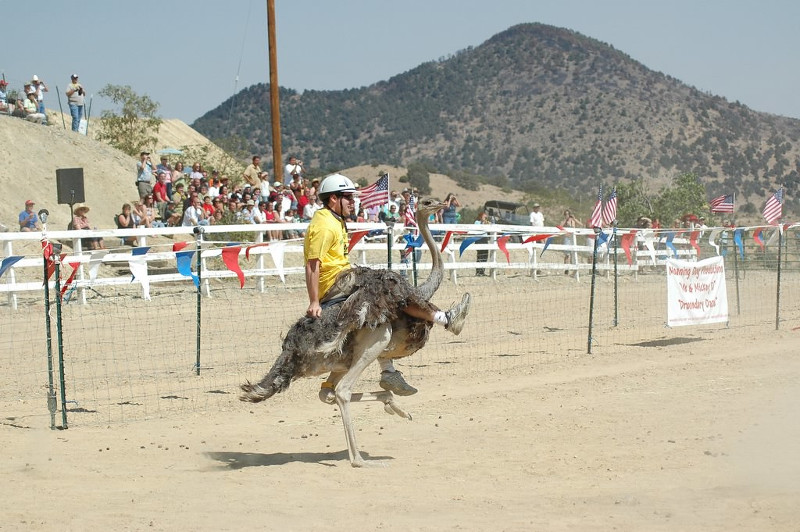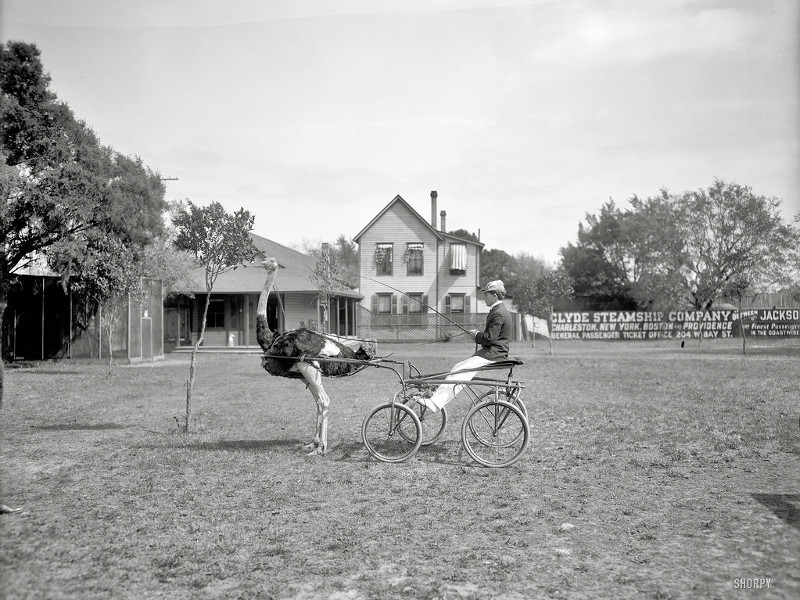Ostrich riding, historically popular for entertainment and leisure, is commonly offered at ostrich farms in places like Oudtshoorn, South Africa. These birds, known for their speed of up to 43mph and ability to carry 160-200 pounds, once served as racing and riding animals.
Ostrich racing, whether in the form of ostrich riding or harness ostrich racing, offers a unique and thrilling experience for both participants and spectators.
However, safety concerns have led to a decline in this practice, especially in the USA. Farms now enforce weight limits and safety precautions to ensure the well-being of both the bird and the rider during these exhilarating experiences.
Ostrich Riding
- In ostrich riding, participants mount the ostrich similar to horseback riding, utilizing reins to guide the bird.
- Ostrich riding emphasizes the rider’s ability to control and direct the ostrich through the racecourse.
- Ostrich riding showcases the agility and speed of the ostrich as it carries the rider towards the finish line.

Harness Ostrich Racing
- Harness ostrich racing involves the ostrich pulling a two-wheeled cart known as a sulky, with a jockey or driver controlling the cart.
- The focus in harness ostrich racing is on the speed and strength of the ostrich as it pulls the sulky along the track.
- It requires skill and coordination from the jockey or driver to navigate the ostrich through the race while maintaining balance and control of the sulky.
- Harness ostrich racing combines the power of the ostrich with the strategic maneuvering of the driver to achieve victory.

The History of Ostrich Racing
Ostrich racing originated in the late 19th century, gaining popularity in countries like South Africa and Australia where ostriches were abundant. Known for their speed and agility, ostriches became a natural choice for racing events, captivating audiences with their impressive running capabilities. The sport spread to the United States and parts of Europe, attracting spectators seeking unconventional entertainment. Despite its unique nature, ostrich racing has stood the test of time, appealing to both participants and onlookers who enjoy the thrill and freedom it offers. The history of ostrich racing reflects humanity’s ongoing pursuit of exciting and distinctive forms of amusement.
Ostrich Racing Vs. Horse Racing
When comparing ostrich racing to horse racing, the contrast between the animals is striking. Ostriches, wild and unpredictable, add chaos and excitement with their unique leg-kicking motion and occasional antics of bucking off jockeys.
In contrast, horse racing exudes elegance and grace, showcasing the trained abilities of these majestic animals. While horse racing is traditional and historical, ostrich racing offers a more entertainingly chaotic spectacle for those seeking a break from the norm.
| Aspect | Ostrich Racing | Horse Racing | Greyhound Racing |
|---|---|---|---|
| Speed | Fast | Fast | Very Fast |
| Agility | High | Moderate | High |
| Unpredictability | High | Moderate | High |
| Popularity | Niche | Mainstream | Mainstream |
Ostrich Racing Events Around the World
Ostrich racing events worldwide showcase the unique athleticism and excitement of these magnificent birds. Participants and spectators are drawn to the thrill of watching these swift and powerful creatures in action. Here are some notable ostrich racing events from around the globe:
| Location | Event | Highlights |
|---|---|---|
| Oudtshoorn, South Africa | Annual Ostrich Races | Known as the ‘ostrich capital of the world’ |
| Chandler, Arizona, USA | Chandler Ostrich Festival | Features ostrich races alongside other entertainment |
| Houston, Texas, USA | Sam Houston Race Park | Features ostrich races alongside other entertainment |
| Virginia City, Nevada, USA | International Camel & Ostrich Races | Features ostrich races alongside other entertainment |
| Altoona, Iowa, USA | Prairie Meadows Racetrack | Features ostrich races alongside other entertainment |
| Warwick, Australia | Ostrich Racing Cup | Riders and their feathered partners compete in high-speed races |
| Abu Dhabi, UAE | Al Wathba Ostrich Race Track | Thrilling races against the backdrop of the desert landscape |
Safety Concerns: Risks and Precautions
Ostrich riding poses risks due to the birds not naturally built to carry loads on their backs, which can lead to weak bones and muscle strain. There is a danger of harm to the bird’s legs and its limited ability to respond to pain or stress.
Ostrich farms help by training the birds to carry weights within safe limits. Understanding and respecting these safety concerns are crucial for the well-being of both the ostrich and the rider.
Ethical Concerns Regarding Ostrich Riding
The ethical implications of ostrich riding raise questions about animal welfare and human responsibility towards these birds.
Ostriches are not anatomically suited for riding, which can cause them physical pain and stress, potentially leading to aggressive behavior. Witnessing animals suffer for human entertainment can be distressing for animal lovers.
It is essential to treat ostriches with respect and prioritize their well-being over our desire for novelty or amusement, prompting us to reconsider our relationship with these creatures.
Physical Risks of Ostrich Riding
Engaging in ostrich riding poses physical hazards for both riders and the ostriches involved. Ostriches, not naturally suited for riding, may experience stress and discomfort due to their bone structure. Riders risk injury from the powerful kicks of these birds, which can reach speeds of up to 45 mph when frightened. Falling off an ostrich can lead to serious harm, as they can react violently when in pain or stressed.
ABTA guidelines advise against activities like ostrich riding due to these dangers. It is recommended to explore alternative, more ethical ways to interact with ostriches that prioritize their well-being.
Alternatives to Ostrich Riding
Explore ethical and educational interactions with ostriches through guided tours, observing their behavior and habitat. Support sanctuaries and conservation efforts, and engage in educational programs to promote respect and understanding for these unique birds.
This holistic approach allows for a deeper connection with ostriches while contributing to their well-being and conservation. It also fosters a sense of responsibility towards these magnificent creatures and their natural habitats.

